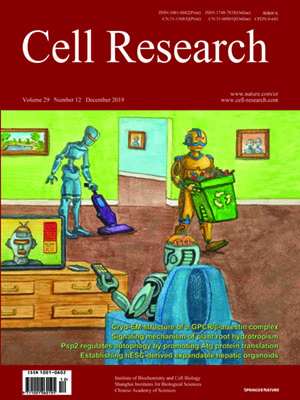
Volume 29, No 12, Dec 2019
ISSN: 1001-0602
EISSN: 1748-7838 2018
impact factor 17.848*
(Clarivate Analytics, 2019)
Volume 29 Issue 12, December 2019: 1035-1038
LETTERS TO THE EDITOR
m6A promotes R-loop formation to facilitate transcription termination
Xin Yang1, Qian-Lan Liu 1,2 , Wei Xu 3, Yi-Chang Zhang 1,2 , Ying Yang 1,2,4 , Lin-Fang Ju 1,2 , Jing Chen 1,2 , Yu-Sheng Chen 1,2, Kuan Li3, Jie Ren 1,2,4,5, Qianwen Sun 3 and Yun-Gui Yang 1,2,4,5
1 CAS Key Laboratory of Genomic and Precision Medicine, Collaborative Innovation Center of Genetics and Development, School of Future Technology, Beijing Institute of Genomics, Chinese Academy of Sciences, Beijing 100101, China; 2University of Chinese Academy of Sciences, Beijing 100049, China; 3Tsinghua-Peking Joint Center for Life Sciences, School of Life Sciences, Tsinghua University, Beijing 100084, China; 4Institute for Stem Cell and Regeneration, Chinese Academy of Sciences, Beijing 100101, China and 5SinoDanish College, University of Chinese Academy of Sciences, Beijing 101408, China
These authors contributed equally: Xin Yang, Qian-Lan Liu, Wei Xu, Yi-Chang Zhang
Correspondence: Jie Ren (renjie@big.ac.cn) or Qianwen Sun (sunqianwen@mail.tsinghua.edu.cn) or YunGui Yang (ygyang@big.ac.cn)
Dear Editor,
R-loops are three-stranded nucleic acid structures consisting of a DNA:RNA heteroduplex and a displaced single DNA strand. They constitute a prevalent genomic feature with important functions in all kingdoms of eukaryotes.1,2,3 For example, R-loops have been found over unmethylated CpG island promoters, G-rich terminators, and many other regulatory chromosomal loci.2,3 Moreover, they are essential for diverse cellular processes, such as immunoglobulin class switching, mitotic chromosome segregation,4 DNA replication and repair, genome stability regulation,5 as well as in multiple steps during transcription.6,7 R-loops can be formed both in cis and in trans; cis R-loops are formed between a nascent RNA and its DNA template following transcribing RNA polymerases and exert co-transcriptional regulatory effects.3,8 Therefore, it is important to control their formation and resolution, and many external factors have already been identified for this process.7 However, it is still unknown whether the intrinsic properties of the RNA itself, such as various modifications, can modulate the formation of DNA:RNA hybrids.
https://doi.org/10.1038/s41422-019-0235-7
FULL TEXT | PDF
Browse 1165


